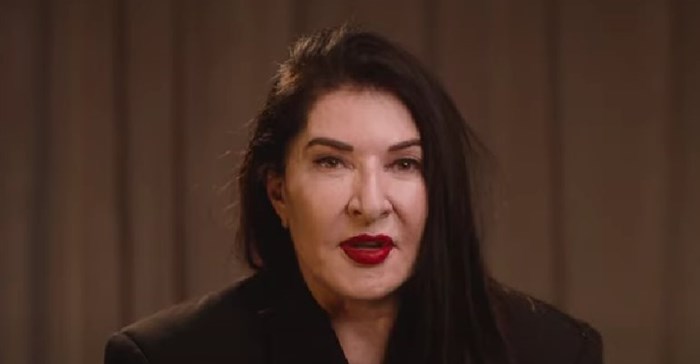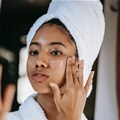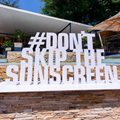
Marina Abramovic is launching a brand. Source: YouTube.
Marina Abramović is frequently described as “the godmother of performance art”. Since the early 1970s, she has been using her own body as material, testing its physical endurance: from rhythmically stabbing a knife between her fingers until she grazed herself 20 times to walking the Great Wall of China.
The new products are being marketed as part of the artist’s “Abramović method”. Both an idea and product, the method is available to purchase as a set of cards with instructions “to reboot your life”.
Abramović’s foray into the wellness industry is not particularly surprising. As of 2024, she positions herself as an artist-cum-life coach, and there is little indication that she might be engaging in satire. Her latest work appears to embrace the kind of New Age vernacular that, outside art, has long been an object of ridicule.
“For decades Abramović has delved into multiple forms of wisdom, including Tibetan Buddhism, Brazilian Shamanism and the beliefs of Aboriginal Australian communities, to learn routes to higher consciousness, often reached by overcoming fears,” claims a recent Modern Art Oxford brochure. If exhibition booklets are often criticised for their vague language, then the substance of Abramović’s recent art complements them perfectly.
Abramović and the history of feminist performance art
It would be easy to describe this venture as just another chapter in the long history of artists “selling out” – but the relationship between beauty and feminist art has a long and complicated history.
Performance has been a productive medium for women artists because of its emphasis on subjectivity. The apparently objective analytical voice characteristic of much art criticism has, in fact, historically had a very specific identity: white and male. To draw attention to the false universality of this perspective, performance artists confronted their audience with their naked, and therefore visibly distinctive, bodies.
The point of early feminist performance art was not to reduce femininity (nor, for that matter, masculinity) to a set of physical characteristics, but to expose previous instances of speaking from a gendered position concealed as critical distance.
Defying the objectification of the feminine subject in art and popular imagery, feminist artists were conscious of the link between physicality and physical appearance. Still, the problem of looks quickly became a thorny issue in feminist circles.
In 1976, critic Lucy Lippard remarked about the artist Hannah Wilke, who often photographed herself nude, that: “Confusion of her roles as beautiful woman and artist, as flirt and feminist, has resulted at times in politically ambiguous manifestations that have exposed her to criticism on a personal as well as on an artistic level.”
The problem faced by “body art”, as the artistic practices that focused on embodiment came to be known, was the long history of representing feminine bodies for the enjoyment of the presumably male spectator. This struggle between fetishisation and individual agency was central to Wilke’s practice.
Wilke photographed herself throughout her career. In 1987, she was diagnosed with lymphoma. She continued to record her body in a photographic series titled Intra-Venus that explicitly showed the impact of illness on her appearance.
When artist Jo Spence sought alternative therapies for cancer, documenting herself in treatment, her desire to escape medicalisation was an act of political protest. The point was to refuse the de-individualised, sick body – subject turned object.
Abramović, on the other hand, claims on the website advertising her products that: “Our need for consumption allowed us to be consumed, and always keeps us hungry for new gadgets to buy. The result of all this is that we have lost our spiritual centre.”
The focus on “spirituality” has replaced her interest in the tension between the self and other, characteristic of performances such as Rhythm 0, where the artist succumbed to the wishes of her audience. On a table, she set out 72 items, ranging from a feather to a gun, and asked the audience to use them “on her”.
Even the power of Abramović’s 2009 work The Artist is Present, a blockbuster exhibition-performance in which Abramović invited visitors to sit opposite her, lay in the fact that it was only deceptively simple. Sitting in a wooden chair for hours on end was an enormous physical feat for Abramović.
And yet, at the recent Royal Academy of Arts retrospective, the work’s documentation focused on faces: Abramović as experienced vis-à-vis her silent interlocutors, who, having queued for hours, were often visibly moved by the encounter.
The strict parameters of Abramović’s works and their engagement with social norms matter no more. What used to be about bodily vulnerability is now about mental strength. Not defiant strength, but the individualistic ideology of strength that makes no distinction between the powerful and the powerless.
The foundations upon which Abramović has built her practice – of transgression, the feminist vanguard – have crumbled. Her art slots neatly into today’s mainstream focus on individual empowerment at the expense of dismantling patriarchy as a structural issue. Voyeurism is welcome.
The irony of selling a £199 face lotion as an antidote to, as Abramović vaguely puts it, “new gadgets” seems too obvious to be genuine – but the stunt is difficult to perceive as subversive.
The French artist Orlan is famous for undergoing a series of invasive procedures to resemble western archetypes of ideal beauty: Mona Lisa’s smooth forehead, Venus’s perfectly shaped chin. By taking objectification to the extreme, Orlan makes it futile. There is nothing we can do to her that she cannot do to herself.
If Abramović’s products were to have a critical edge, it would be as part of Orlan’s beauty routine: a lotion so good it makes you break out.

This article is republished from The Conversation under a Creative Commons license. Read the original article.


















































